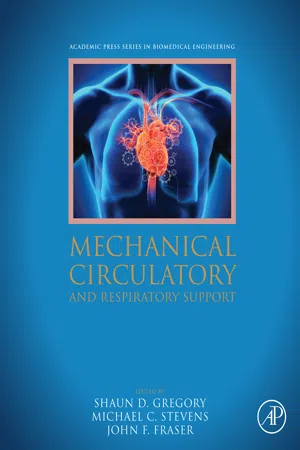
Mechanical Circulatory and Respiratory Support
Shaun Gregory,John Fraser,Michael Stevens
- 852 pages
- English
- ePUB (mobile friendly)
- Available on iOS & Android
Mechanical Circulatory and Respiratory Support
Shaun Gregory,John Fraser,Michael Stevens
About This Book
Mechanical Circulatory and Respiratory Support is a comprehensive overview of the past, present and future development of mechanical circulatory and respiratory support devices. Content from over 60 internationally-renowned experts focusses on the entire life-cycle of mechanical circulatory and respiratory support – from the descent into heart and lung failure, alternative medical management, device options, device design, implantation techniques, complications and medical management of the supported patient, patient-device interactions, cost effectiveness, route to market and a view to the future.
This book is written as a useful resource for biomedical engineers and clinicians who are designing new mechanical circulatory or respiratory support devices, while also providing a comprehensive guide of the entire field for those who are already familiar with some areas and want to learn more. Reviews of the most cutting-edge research are provided throughout each chapter, along with guides on how to design new devices and which areas require specific focus for future research and development.
- Covers a variety of disciplines, from anatomy of organs and evolution of cardiovascular devices, to their clinical applications and the manufacturing and marketing of devices
- Provides engineering and clinical perspectives to assist readers in the design of a market appropriate device
- Discusses history, design, usage, and development of mechanical circulatory and respiratory support systems
Frequently asked questions
Information
Descent into heart and lung failure
† Interdepartmental Division of Critical Care Medicine University Health Network/Mount Sinai Hospital, Toronto, ON, Canada
‡ Extracorporeal Life Support Program, University Health Network, Toronto, ON, Canada
Abstract
Keywords
Acknowledgment
Introduction
Cardiac Anatomy and Physiology
Heart Chambers

Table of contents
- Cover image
- Title page
- Table of Contents
- Copyright
- Contributors
- Preface
- Acknowledgments
- Part 1: Heart Failure and Nondevice Treatment
- Part 2: Types of Cardiovascular Devices
- Part 3: Pump Design
- Part 4: Implantation and Medical Management
- Part 5: Physiological Interaction Between the Device and Patient
- Part 6: Route to Market (and Staying There!)
- Part 7: Summary
- Index